DOI:10.32604/csse.2023.025190

| Computer Systems Science & Engineering DOI:10.32604/csse.2023.025190 |  |
| Article |
Intelligent Deep Learning Enabled Wild Forest Fire Detection System
Department of Information Systems, College of Computer and Information Sciences, Prince Sultan University, Riyadh, 11586, Saudi Arabia
*Corresponding Author: Ahmed S. Almasoud. Email: almasoud@psu.edu.sa
Received: 15 November 2021; Accepted: 28 December 2021
Abstract: The latest advancements in computer vision and deep learning (DL) techniques pave the way to design novel tools for the detection and monitoring of forest fires. In this view, this paper presents an intelligent wild forest fire detection and alarming system using deep learning (IWFFDA-DL) model. The proposed IWFFDA-DL technique aims to identify forest fires at earlier stages through integrated sensors. The proposed IWFFDA-DL system includes an Integrated sensor system (ISS) combining an array of sensors that acts as the major input source that helps to forecast the fire. Then, the attention based convolution neural network with bidirectional long short term memory (ACNN-BLSTM) model is applied to examine and identify the existence of danger. For hyperparameter tuning of the ACNN-BLSTM model, the bacterial foraging optimization (BFO) algorithm is employed and thereby enhances the detection performance. Finally, when the fire is detected, the Global System for Mobiles (GSM) modem transmits messages to the authorities to take required actions. An extensive set of simulations were performed and the results are investigated interms of several aspects. The obtained results highlight the betterment of the IWFFDA-DL technique interms of various measures.
Keywords: Forest fire; deep learning; intelligent models; metaheuristics; integrated sensor system; hyperparameter tuning
At present, forest fires (FF) are frequently causing severe threats to the environment and producing natural disasters and real emergency situations. The response time of emergency corps dramatically affects the losses and consequences produced by them; hence the improvement of forest fire detection (FFD) and prevention schemes could be consider a primary objective to conserve the environment [1]. Regarding this, monitoring in real time of specific environment variables could make the FF fighting, detection, and prevention very effective. Various kinds of environmental risk issues could be assumed that evaluate the presence of FF theatres over diverse forest regions. Alternatively, uncommon changes of dynamic FF threats like polluting gases, oxygen level, or meteorological variables assessed in real-time could be analyzed which focus on carrying out a short-term prediction of FF risk [2]. At the same time, static FF risks like topography, vegetation layer, or frequency of FF might be helpful for performing a long-term prediction of FF risk since vegetation impacted by climatic change over time and some topography parameters (for example the presence of elevated slopes) might have a direct effect on the possibility of fire existence [3]. Similarly, increasing temperature values, unusual reduction of oxygen level or humidity values together with the concentration of some pollutant gases, namely carbon monoxide and carbon dioxide, might include a great possibility of outbreaks of nearby fires [4].
Hence, environment observing could make the response time of emergency corps very effective. Also, Fire spread could be predicted by analyzing the value of change in wind direction, the oxygen levels on neighboring forest regions, and meteorological variables, since this variable has a direct effect on related fire propagation features like organic fuels and dryness of vegetation [5]. A wireless sensor network (WSN) based Internet of Things (IoT) sensors and devices could be utilized for performing real-time environmental monitoring of the abovementioned FF risks. The distribution and design must be tackled which focuses on covering forest regions as possible. Relating to this, various problems should be examined, for example, the security of wireless transmission between distributed sensors and the authentication of sensors considering potential range outside the coverage area [6].
Current developments in remote sensing, computer vision, and machine learning (ML) techniques provide new methodologies for monitoring and detecting FF [7], whereas the growth of new microelectronics and materials have permitted sensor nodes to be very effective in finding active FFs. Different from other fire detection studies which have concentrated on several sensing techniques, on smoke/video flame technologies in InfraRed (IR)/visible range, on airborne systems, and different environments, also offer extensive research of the most representative FFD system, focuses on those that use digital image processing, and classification and optical remote sensing technologies [8]. Based on the acquisition level, three major classes of broadly employed methods which could monitor/detect active smoke/fire occurrences in real-time were discussed and recognized, viz., satellite, terrestrial and aerial. Such techniques are generally armed with multispectral, visible, or IR sensor nodes that information is processed using ML methodologies [9]. Those techniques are based either on powerful deep learning (DL) networks/the extraction of hand-crafted features for earlier recognition of FFs and also for modelling smoke/fire behaviours [10].
Jiao et al. [11] present an FFD method by using you only look once (YOLO)v3 to unmanned aerial vehicles (UAV) based images. Initially, a UAV architecture is proposed with the aim of detecting FFs. Next, based on the existing computational power of the onboard hardware, a small-scale convolutional neural network (CNN) is implemented by using YOLOv3. Xu et al. [12], proposed a different ensemble learning technique to identify FFs in various situations. Initially, 2 individual learners EfficientDet and Yolov5 are incorporated for accomplishing fire detection tasks. Next, for other individual learners, EfficientNet is accountable for learning global data to prevent false positives. Lastly, recognition outcomes are made according to the decision of 3 learners.
Angayarkkani et al. [13] introduce a smart technology for detecting the occurrence of FFs in the forest spatial data with artificial neural network (ANN) model. The digital images are changed from RGB to XYZ colour space and partitioned by using anisotropic diffusion to detect the fire areas. Then, RBFNN method is used in the development of the smart technology that can be trained by the colour space values of the partitioned fire areas. In Zhang et al. [14], Fast region based convolutional neural network (RCNN) was employed for detecting wildland FF to prevent the automatic feature extraction method in conventional video smoke detecting method. Synthetic smoke image is made by injecting simulative/real smoke to forest backgrounds for solving the absence of trained information.
Kinaneva et al. [15] develop a novel method for fire control and detection, where current techniques are employed. Especially, proposed an architecture which employs UAV that continuously patrols over possible fire areas. Also, The UAV utilizes the advantages of artificial intelligence (AI) method and is armed with on-board processing abilities. It enables us to utilize computer vision (CV) methodology for the detection and recognition of fire/smoke, as per the video input/images from the drone cameras. Jiao et al. [16], proposed a DL fire detecting method, focus on enhancing the detective efficiency and accuracy by utilizing the UAV. Firstly, A largescale YOLOv3 network is designed that could guarantee recognition performance. Then, the method is employed for UAV-FFD architecture, in which the fire images are taken using the UAV and transferred to ground station from real time.
Pan et al. [17] design a video-based wildfire detecting system based on computational effective additive deep neural network (DNN) that is called as AddNet. This AddNet is depending on a multiplication-free vector operator that only accomplishes sign manipulation and addition operations. Regarding this, we create dot product-like operations from the mf-operators and utilize them for defining convolution and dense feed-forward passes in AddNet.
This paper presents an intelligent wild forest fire detection and alarming system using deep learning (IWFFDA-DL) model. The proposed IWFFDA-DL technique aims to identify forest fires at earlier stages through integrated sensors. Besides, an integrated sensor system (ISS) comprising several sensors is used to gather the input source data. In addition, the attention based convolution neural network with bidirectional long short term memory (ACNN-BLSTM) is used for the detection of forest fire. To perform hyperparameter tuning of the ACNN-BLSTM model, the bacterial foraging optimization (BFO) algorithm is employed and thereby enhances the detection performance. At last, when the fire is detected, the GSM modem transmits messages to the authorities to take required actions. A wide range of experimental analyses is carried out and the outcomes are inspected under several measures.
The rest of the paper is organized as follows. Section 2 offers the proposed model, Section 3 provides the experimental validation, and Section 4 draws the conclusion.
The presented method aims at 2 major features: (1) earlier detection of FF and (2) informing the relevant authority to rescue. First, the detection units include flame, smoke, and heat detector; further, a camera is connected to confirm the actual fire images. Next, based on the amount of fire the controller would implement several concurrent operations; since it will be switching on the water sprinkler, sound a fire alarm to report it immediately, inform the emergency service units, turn off the electrical power supply and the owner by transmitting a data includes the address of the property. Fig. 1 illustrates the overall working process of proposed IWFFDA-DL method.
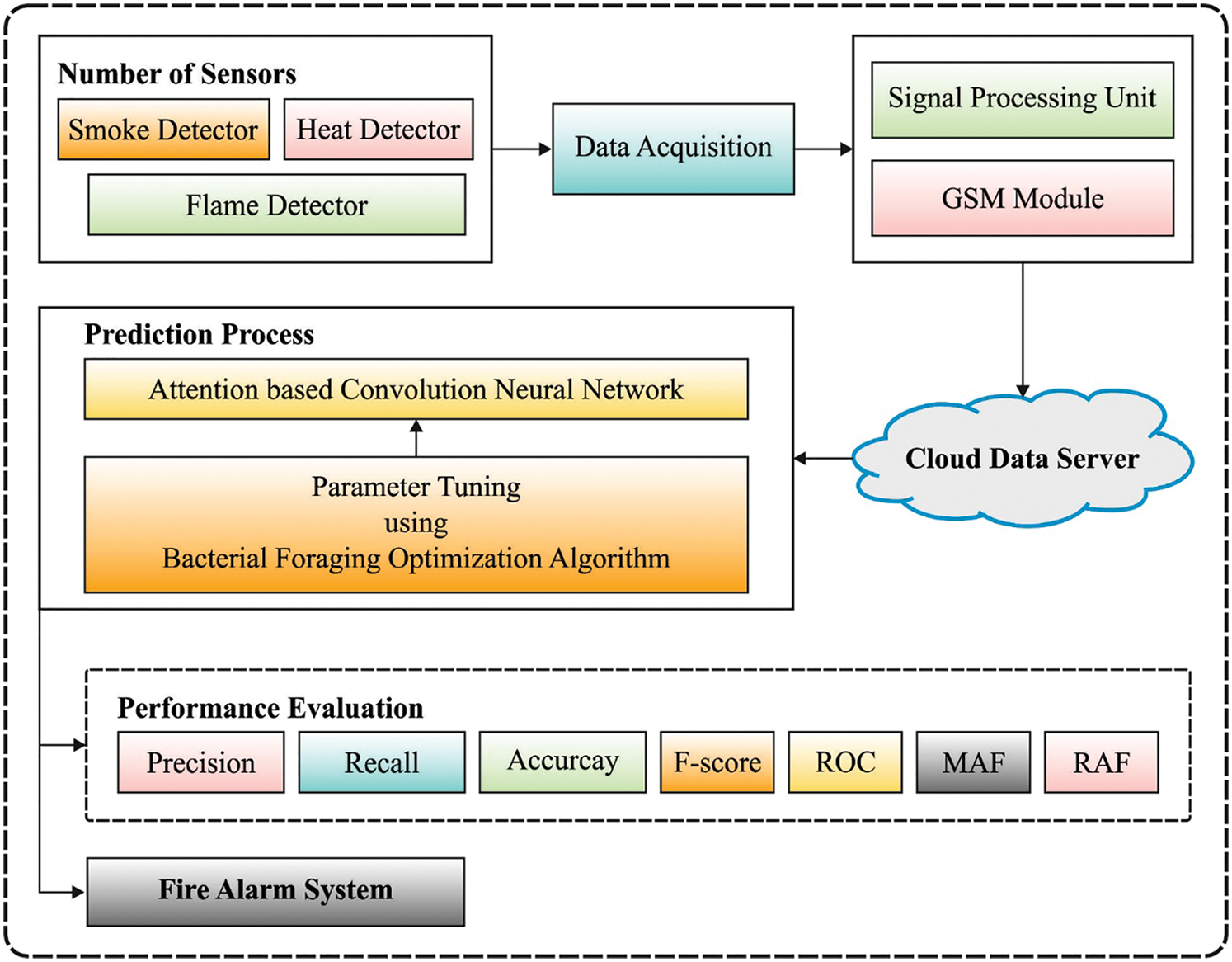
Figure 1: Overall process of proposed IWFFDA-DL method
It is an integration of multiple detectors utilized in this method. This detector is the major source of input data which assists to forecast the fire. A digital camera is connected for consolidating the signal gathered from the detector. By integrating these 2 methods, the whole intelligent fire recognition method is determined for providing very precise detection.
It integrates each module in single unit for example the GSM, integrated sensor system (ISS), and image processing modules. In the presented model, socket programming via Wireless Fidelity (Wi-Fi) shield help the wireless transmission. For example, there are many ISSs in a room. All the ISSs are allocated with a different number and it has location data. It employs this location data to define the precise fire location. To initiate the multi-data fusion method, micro-controller allocates a threshold. It analyses the sensory information to define the optimum perception method to identify possible fires. Based on the consequence of processed outcome, the scheme prioritizes the results and forward them to the emergency service through image processing method.
2.3 Fire Detection Using ACNN-BLSTM Model
For the effective detection of FF, the ACNN-BLSTM model is applied to it. For extracting features effectually and enhancing forecast accuracy, it can be integrated CNN, BLSTM network, and lightweight Effective Channel Attention (ECA) component as to a unified structure and present a novel time series forecast network method called ACNN-BLSTM. In presented technique is automatically learning as well as extracting local feature and long memory features from the time series by producing complete utilize of data for minimizing the difficulty of models. In addition, the attention process has been more established for extracting further essential features. Fig. 2 depicts the framework of BLSTM technique.
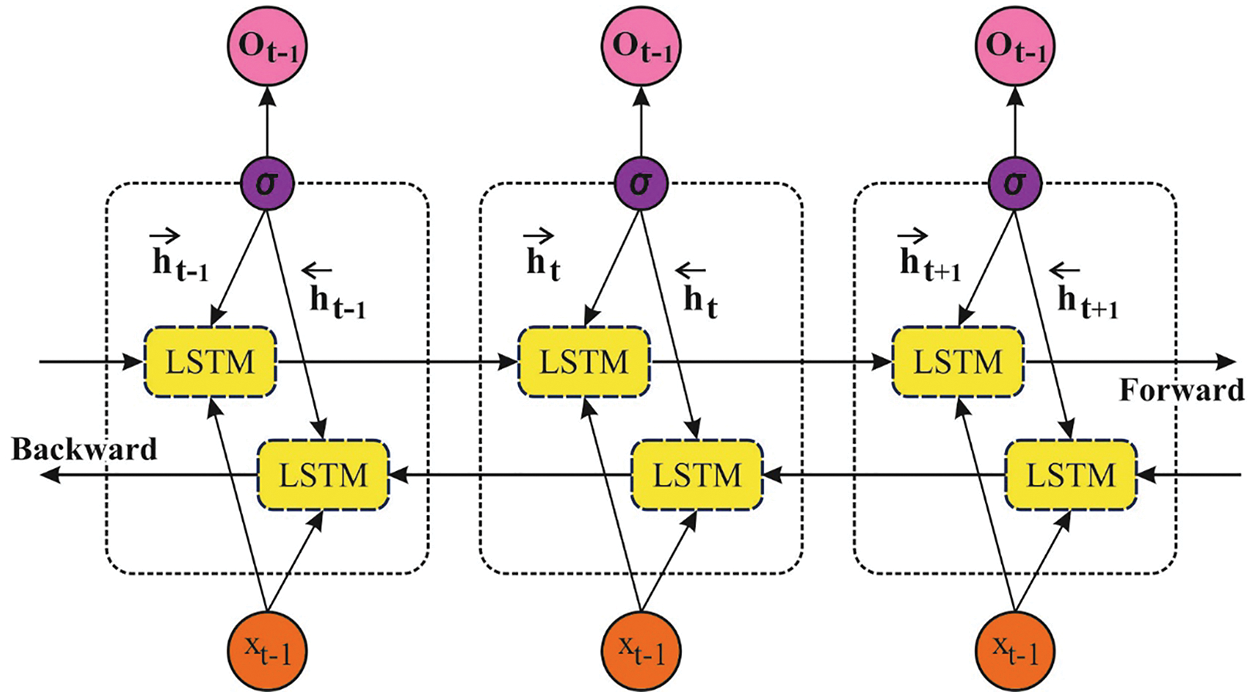
Figure 2: Structure of BLSTM model
Lastly, the dense method containing many fully connected (FC) layers was utilized for performing the forecast tasks. During this case, CNN was employed for extracting data features effectually. Related to the typical neural network (NN) framework, CNN has local connection amongst neurons that decreases the amount of parameters amongst the connection layer. Specifically, it comprises a part of connection amongst
Channel Attention (CA) process is a huge potential for enhancing the efficiency of deep convolutional neural network (DCNN). But, one of the presented approaches is committed to designing further difficult attention components for achieving optimum efficiency that inevitably improves the difficulty and computational burden of method. For avoiding over-fit of method and decrease the calculation, a lightweight and minimum difficulty component named ECA was established. The ECA could not only create the weights to all channels, along learn the correlation amongst the distinct channels. To the time series data, the superior weight has been allocated to the key feature and lesser weight to the irrelevant feature [18]. So, ECA efforts on the suitable data that enhances the sensitivity of network to essential features. The ECA has primary for implementing channel Global Average Pooling (GAP). Afterward, ECA utilizes all the channels and their
where
So, to provide the channel dimensional
where
In order to optimally choose the hyperparameter involved in the ACNN-BLSTM model, the BFO algorithm is utilized. BFO is novel, nature simulated optimization method developed by Kevin Passino in 2002 [19]. The group foraging behavior of bacteria’s like E. coli and M. xanthus stimulated the growth of BFO. BFO has become an influential and effective optimization method which offers higher convergence speed as well as accuracy employed in the amount of real time applications. BFO method is stimulated by chemotaxis performance of virtual bacteria which move toward (under the direction
Chemotaxis
It is the procedure of E. coli movement which search for nutrient rich position through flagella (locomotory organelles). Once it searches in opposed direction from the previous steps then this procedure is called tumbling and once it searches is in a similar direction to the previous steps then this procedure is called swimming [20]. The movement of chemotactic of the bacterium can be determined as follows
whereas
Swarming
Bacteria’s namely S. typhimurium and E. coli, once inspired by a higher level of succinate, illustrates a stimulating group behavior by discharging an attractant aspartate. This aspartate assists the nutrient gradient which has a certain design from moving of swarm with higher velocity. With this repellent and attractant, the cell to cell interaction to swarm is as follows
In which
Primarily, all the frames undergoes YOLO v3 based object detection process for identifying and the presented method could transfer data to user via GSM modem. It can be kind of wireless device developed to the transmission of a computer using the General Packet Radio Service (GPRS) and GSM systems. It needs a subscriber identity module (SIM) card for activating transmission and International Mobile Equipment Identity (IMEI) number for ID. The WSN collects the room condition data and transmits data to the data storage for analyzing the cause of fire. Afterward receiving the signals from microcontroller, the GSM modem forwards short messaging service (SMS) to authority and so it could be notified and take appropriate action. The SMS sending procedure varies according to the amount of the fire.
This section elaborates on the FF prediction performance of the IWFFDA-DL technique. The results are examined using a dataset, which comprises three classes of fire status namely normal, potential, and extreme. Under the normal fire status, the value of heat (C) is less than 55°C, flame less than 180 μm, and smoke less than 50 dB/m. Besides, under the potential fire status, the value of heat (C) is between 55°C–65°C, flame between 180–190 μm, and smoke between 50–150 dB/m. In addition, under the extreme fire status, the value of heat (C) is greater than 65°C, flame greater than 190 μm, and smoke greater than 150 dB/m.
Fig. 3 offers a set of ten confusion matrices generated by the IWFFDA-DL technique under ten runs. The results show that the IWFFDA-DL technique has gained improved outcomes under all runs. For instance, under run-1, the IWFFDA-DL technique has identified 15 instances into Normal, 91 instances into Potential, and 189 instances into Extreme. Besides, under run-4, the IWFFDA-DL manner has identified 17 instances into Normal, 92 instances into Potential, and 188 instances into Extreme. Moreover, under run-6, the IWFFDA-DL technique has identified 15 instances into Normal, 87 instances into Potential, and 189 instances into Extreme. Eventually, under run-8, the IWFFDA-DL algorithm has identified 18 instances into Normal, 92 instances into Potential, and 186 instances into Extreme. Meanwhile, under run-10, the IWFFDA-DL system has identified 18 instances into Normal, 91 instances into Potential, and 189 instances into Extreme.
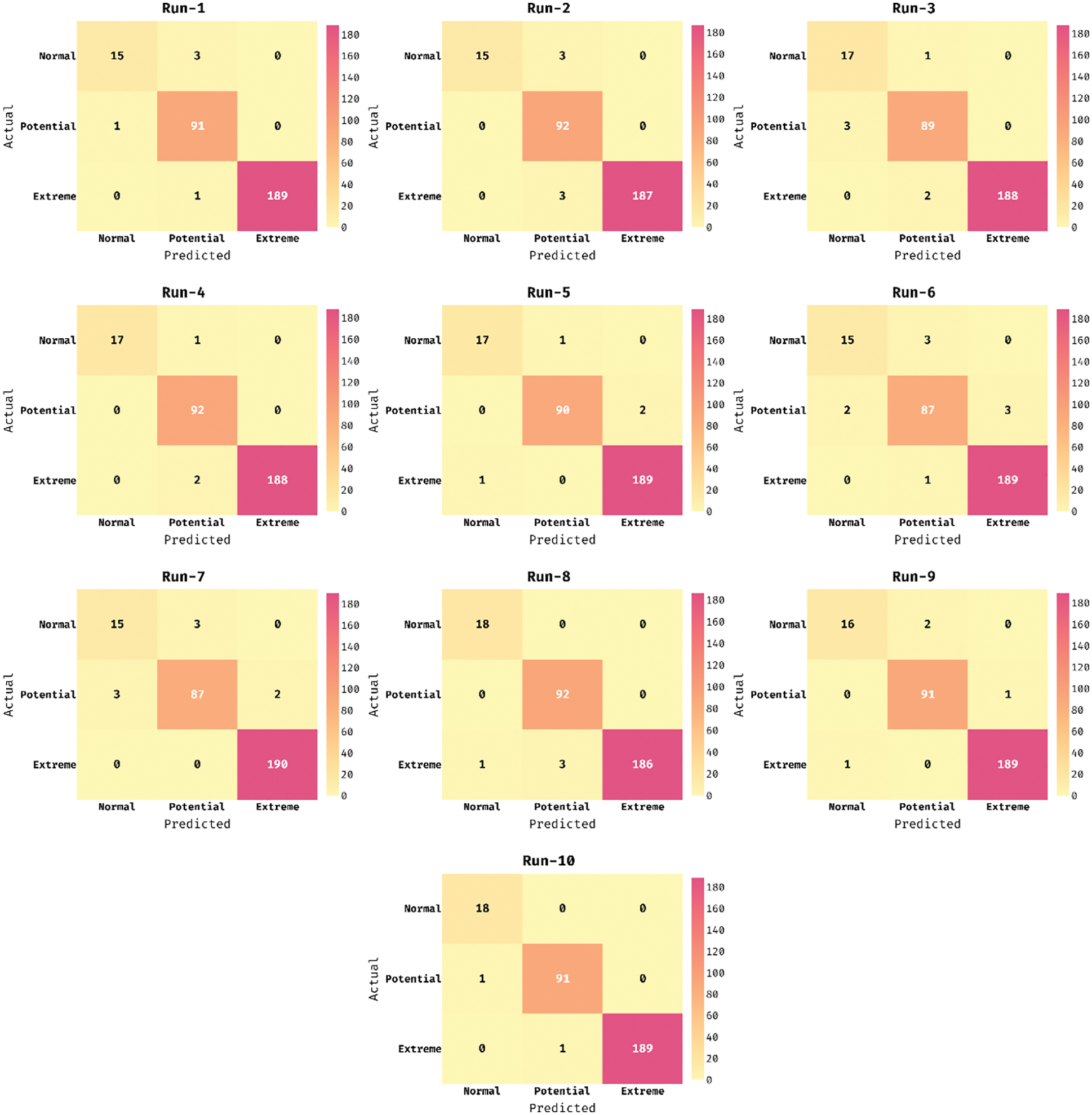
Figure 3: Confusion matrix of IWFFDA-DL technique with various runs
An overall classification results analysis of the IWFFDA-DL technique under ten runs is given in Tab. 1. The results are examined under different performance measures and the results notified that the IWFFDA-DL technique has accomplished improved performance on the classification of distinct class labels.

An overall forest fire prediction performance analysis of the IWFFDA-DL technique take place in Tab. 2. The results show that the IWFFDA-DL technique has accomplished superior outcomes under all runs. For instance, with run-1, the IWFFDA-DL technique has gained

A clear receiver operating characteristic (ROC) curve analysis of the IWFFDA-DL technique takes place on test dataset in Fig. 4. The results reported that the IWFFDA-DL technique has the ability to accomplish enhanced performance with the increased ROC of 99.9571.

Figure 4: ROC analysis of IWFFDA-DL technique
Fig. 5 offers the accuracy analysis of the IWFFDA-DL technique under distinct number of epochs. The figure revealed that the IWFFDA-DL technique has gained increased training and validation accuracies with increased epochs.
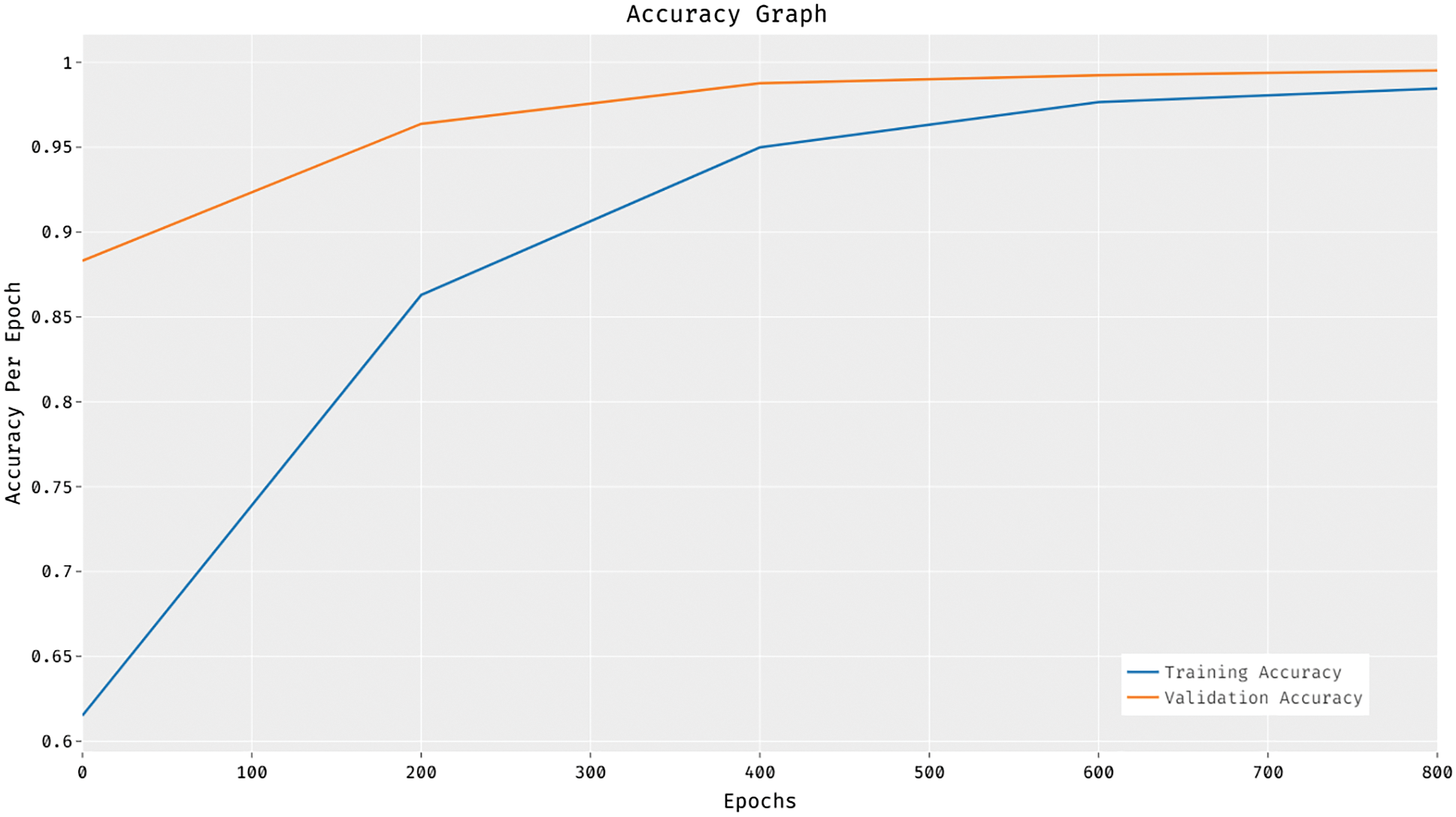
Figure 5: Accuracy graph analysis of IWFFDA-DL approach
In order to showcase the outstanding performance of the IWFFDA-DL technique IWFFDA-DL technique, a brief comparative analysis is made in Tab. 3 [21].

The comparative
The comparative
The brief
Fig. 6 provides the loss analysis of the IWFFDA-DL technique under distinct number of epochs. The figure revealed that the IWFFDA-DL technique has gained reduced training and validation accuracies with increased epochs.
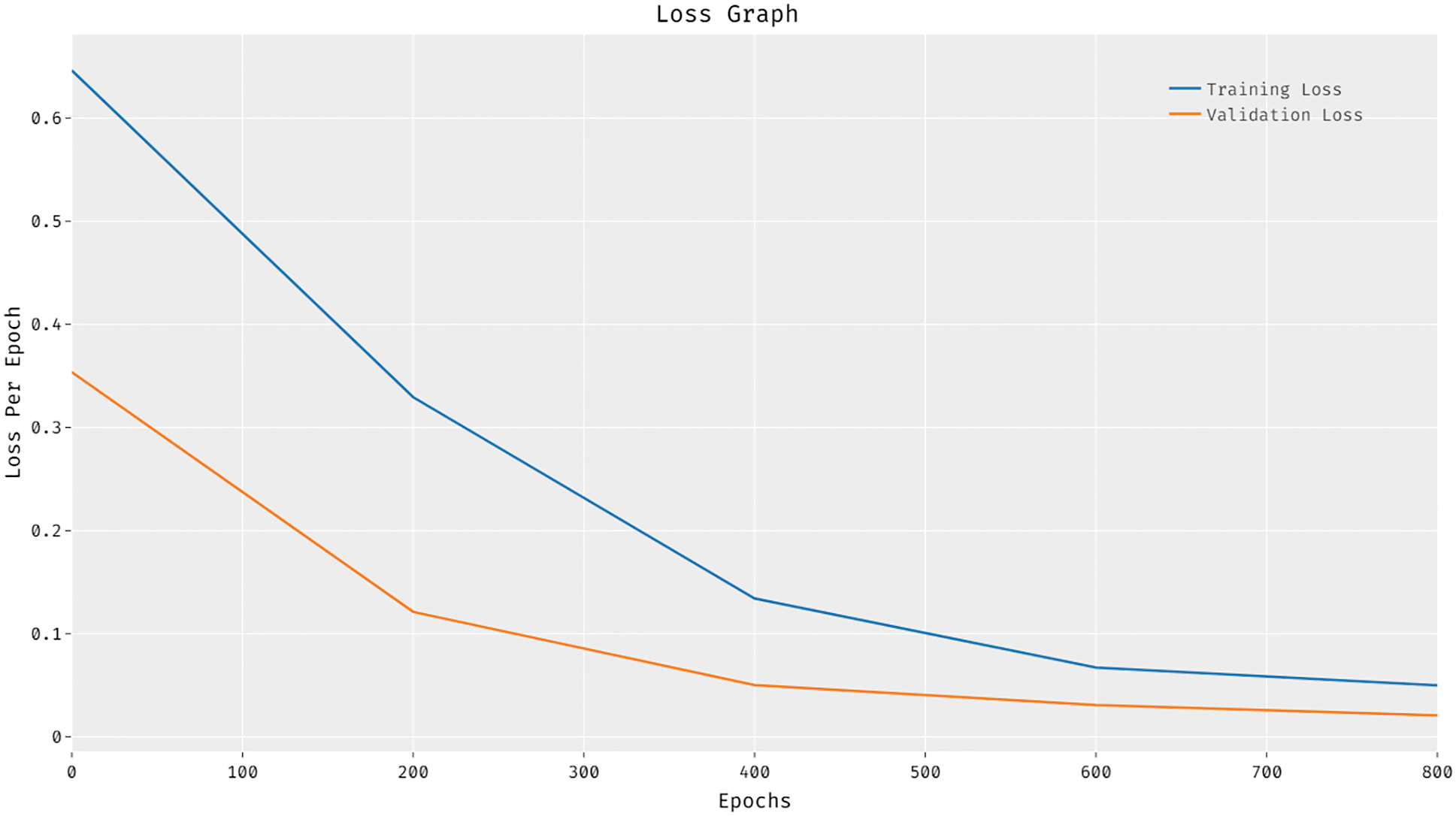
Figure 6: Loss graph analysis of IWFFDA-DL technique
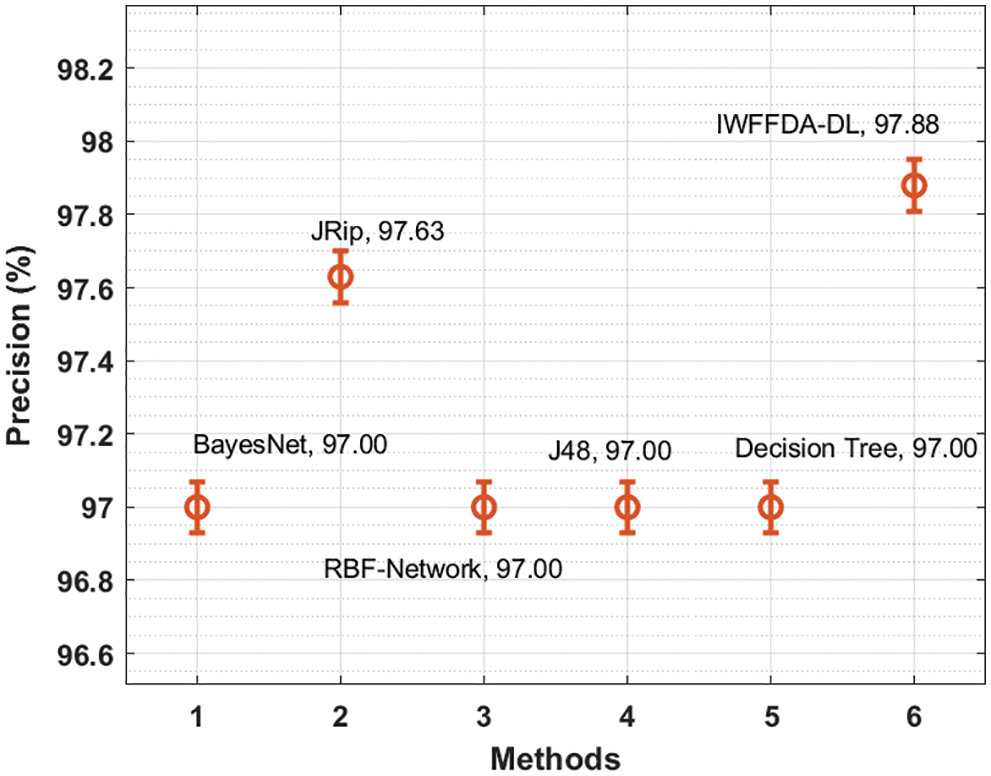
Figure 7: Precision analysis of IWFFDA-DL manner with existing techniques

Figure 8: Recall analysis of IWFFDA-DL manner with existing techniques
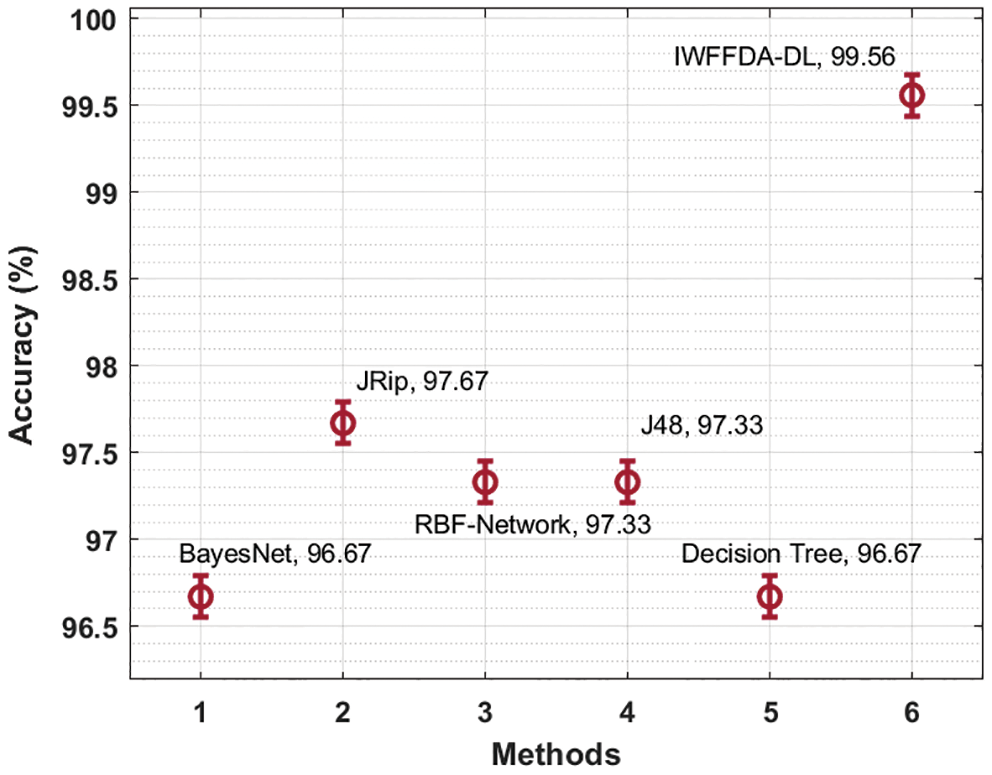
Figure 9: Accuracy analysis of IWFFDA-DL manner with existing techniques
From these results analysis, it can be concluded that the IWFFDA-DL technique has the capability of proficiently detecting and alerting the forest fire.
In this study, a new IWFFDA-DL technique has been proposed to identify forest fires at earlier stages through integrated sensors. The proposed IWFFDA-DL technique involves the ISS comprising several sensors that are used to gather the input source data. In addition, the ACNN-BLSTM model is used for the detection of forest fires. At last, when the fire is detected, the GSM modem transmits messages to the authorities to take required actions. A wide range of experimental analyses is carried out and the outcomes are inspected under several measures. In order to optimally choose the hyperparameter involved in the ACNN-BLSTM model, the BFO algorithm is utilized. The obtained results highlight the betterment of the IWFFDA-DL technique interms of various measures. As a part of future scope, DL based image processing techniques can be employed to classify the images into fire and not fire.
Funding Statement: The author would like to acknowledge the support of prince sultan university for paying the article processing charges (APC) of this publication.
Conflicts of Interest: The authors declare that they have no conflicts of interest to report regarding the present study.
1. P. Barmpoutis, P. Papaioannou, K. Dimitropoulos and N. Grammalidis, “A Review on early forest fire detection systems using optical remote sensing,” Sensors, vol. 20, no. 22, pp. 6442, 2020. [Google Scholar]
2. B. Pradhan, M. D. H. B. Suliman and M. A. B. Awang, “Forest fire susceptibility and risk mapping using remote sensing and geographical information systems (GIS),” Disaster Prevention and Management, vol. 16, no. 3, pp. 344–352, 2007. [Google Scholar]
3. K. Bouabdellah, H. Noureddine and S. Larbi, “Using wireless sensor networks for reliable forest fires detection,” Procedia Computer Science, vol. 19, pp. 794–801, 2013. [Google Scholar]
4. A. Gaur, A. Singh, A. Kumar, K. S. Kulkarni, S. Lala et al., “Fire sensing technologies: A review,” IEEE Sensors Journal, vol. 19, no. 9, pp. 3191–3202, 2019. [Google Scholar]
5. A. Gaur, A. Singh, A. Kumar, A. Kumar and K. Kapoor, “Video flame and smoke based fire detection algorithms: A literature review,” Fire Technology, vol. 56, no. 5, pp. 1943–1980, 2020. [Google Scholar]
6. R. Kaabi, S. Frizzi, M. Bouchouicha, F. Fnaiech and E. Moreau, “Video smoke detection review: State of the art of smoke detection in visible and IR range,” in 2017 Int. Conf. on Smart, Monitored and Controlled Cities (SM2C), Sfax, Tunisia, pp. 81–86, 2017. [Google Scholar]
7. J. T. Castro, P. C. Gil, N. R. Pérez, I. S. González, C. H. Goya et al., “Forest fire prevention, detection, and fighting based on fuzzy logic and wireless sensor networks,” Complexity, vol. 2018, pp. 1–17, 2018. [Google Scholar]
8. N. Venkateswaran and K. Umadevi, “Hybridized wrapper filter using deep neural network for intrusion detection,” Computer Systems Science and Engineering, vol. 42, no. 1, pp. 1–14, 2022. [Google Scholar]
9. K. Sathya and M. Rajalakshmi, “RDA-CNN: Enhanced super resolution method for rice plant disease classification,” Computer Systems Science and Engineering, vol. 42, no. 1, pp. 33–47, 2022. [Google Scholar]
10. C. Yuan, Y. Zhang and Z. Liu, “A survey on technologies for automatic forest fire monitoring, detection, and fighting using unmanned aerial vehicles and remote sensing techniques,” Canadian Journal of Forest Research, vol. 45, no. 7, pp. 783–792, 2015. [Google Scholar]
11. Z. Jiao, Y. Zhang, J. Xin, L. Mu, Y. Yi et al., “A deep learning based forest fire detection approach using UAV and YOLOv3,” in 2019 1st Int. Conf. on Industrial Artificial Intelligence (IAI), Shenyang, China, pp. 1–5, 2019. [Google Scholar]
12. R. Xu, H. Lin, K. Lu, L. Cao and Y. Liu, “A forest fire detection system based on ensemble learning,” Forests, vol. 12, no. 2, pp. 217, 2021. [Google Scholar]
13. K. Angayarkkani and N. Radhakrishnan, “An intelligent system for effective forest fire detection using spatial data,” International Journal of Computer Science and Information Security, vol. 7, no. 1, pp. 202–208, 2010. [Google Scholar]
14. Q. Zhang, G. Lin, Y. Zhang, G. Xu and J. Wang, “Wildland forest fire smoke detection based on faster r-cnn using synthetic smoke images,” Procedia Engineering, vol. 211, no. 3, pp. 441–446, 2018. [Google Scholar]
15. D. Kinaneva, G. Hristov, J. Raychev and P. Zahariev, “Early forest fire detection using drones and artificial intelligence,” in 2019 42nd Int. Convention on Information and Communication Technology, Electronics and Microelectronics (MIPRO), Opatija, Croatia, pp. 1060–1065, 2019. [Google Scholar]
16. Z. Jiao, Y. Zhang, L. Mu, J. Xin, S. Jiao et al., “A YOLOv3-based learning strategy for real-time uav-based forest fire detection,” in 2020 Chinese Control and Decision Conf. (CCDC), Hefei, China, pp. 4963–4967, 2020. [Google Scholar]
17. H. Pan, D. Badawi, X. Zhang and A. E. Cetin, “Additive neural network for forest fire detection,” Signal Image and Video Processing, vol. 14, no. 4, pp. 675–682, 2020. [Google Scholar]
18. Y. Chen, R. Fang, T. Liang, Z. Sha, S. Li et al., “Stock price forecast based on CNN-BiLSTM-ECA model,” Scientific Programming, vol. 2021, no. 1, pp. 1–20, 2021. [Google Scholar]
19. K. M. Passino, “Biomimicry of bacterial foraging for distributed optimization and control,” IEEE Control Systems Magazine, vol. 22, no. 3, pp. 52–67, 2002. [Google Scholar]
20. H. Chen, Q. Zhang, J. Luo, Y. Xu and X. Zhang, “An enhanced bacterial foraging optimization and its application for training kernel extreme learning machine,” Applied Soft Computing, vol. 86, no. 11, pp. 105884, 2020. [Google Scholar]
21. M. S. Mahmud, M. S. Islam and M. A. Rahman, “Smart fire detection system with early notifications using machine learning,” International Journal of Computational Intelligence Systems, vol. 16, no. 2, pp. 1750009, 2017. [Google Scholar]
 | This work is licensed under a Creative Commons Attribution 4.0 International License, which permits unrestricted use, distribution, and reproduction in any medium, provided the original work is properly cited. |